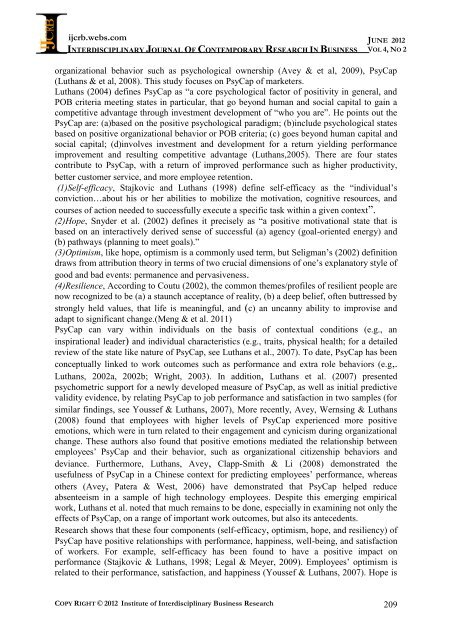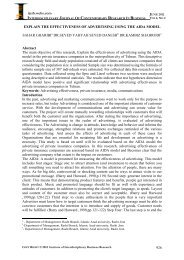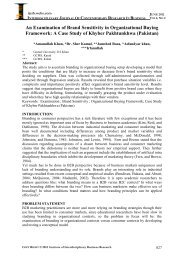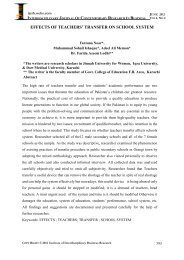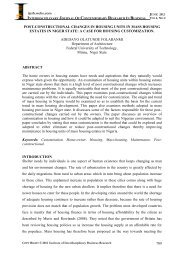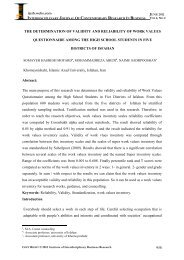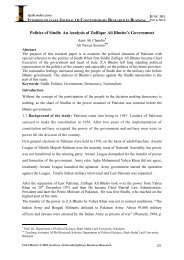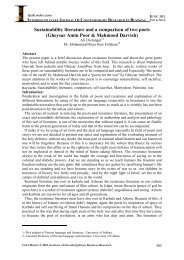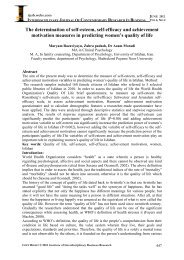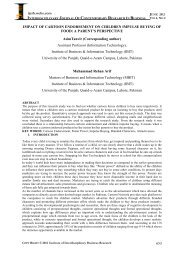The Role of the Psychological Capital on Quality of Work Life And ...
The Role of the Psychological Capital on Quality of Work Life And ...
The Role of the Psychological Capital on Quality of Work Life And ...
Create successful ePaper yourself
Turn your PDF publications into a flip-book with our unique Google optimized e-Paper software.
ijcrb.webs.com<br />
INTERDISCIPLINARY JOURNAL OF CONTEMPORARY RESEARCH IN BUSINESS<br />
COPY RIGHT © 2012 Institute <str<strong>on</strong>g>of</str<strong>on</strong>g> Interdisciplinary Business Research<br />
JUNE 2012<br />
VOL 4, NO 2<br />
organizati<strong>on</strong>al behavior such as psychological ownership (Avey & et al, 2009), PsyCap<br />
(Luthans & et al, 2008). This study focuses <strong>on</strong> PsyCap <str<strong>on</strong>g>of</str<strong>on</strong>g> marketers.<br />
Luthans (2004) defines PsyCap as “a core psychological factor <str<strong>on</strong>g>of</str<strong>on</strong>g> positivity in general, and<br />
POB criteria meeting states in particular, that go bey<strong>on</strong>d human and social capital to gain a<br />
competitive advantage through investment development <str<strong>on</strong>g>of</str<strong>on</strong>g> “who you are”. He points out <str<strong>on</strong>g>the</str<strong>on</strong>g><br />
PsyCap are: (a)based <strong>on</strong> <str<strong>on</strong>g>the</str<strong>on</strong>g> positive psychological paradigm; (b)include psychological states<br />
based <strong>on</strong> positive organizati<strong>on</strong>al behavior or POB criteria; (c) goes bey<strong>on</strong>d human capital and<br />
social capital; (d)involves investment and development for a return yielding performance<br />
improvement and resulting competitive advantage (Luthans,2005). <str<strong>on</strong>g>The</str<strong>on</strong>g>re are four states<br />
c<strong>on</strong>tribute to PsyCap, with a return <str<strong>on</strong>g>of</str<strong>on</strong>g> improved performance such as higher productivity,<br />
better customer service, and more employee retenti<strong>on</strong>.<br />
(1)Self-efficacy, Stajkovic and Luthans (1998) define self-efficacy as <str<strong>on</strong>g>the</str<strong>on</strong>g> “individual’s<br />
c<strong>on</strong>victi<strong>on</strong>…about his or her abilities to mobilize <str<strong>on</strong>g>the</str<strong>on</strong>g> motivati<strong>on</strong>, cognitive resources, and<br />
courses <str<strong>on</strong>g>of</str<strong>on</strong>g> acti<strong>on</strong> needed to successfully execute a specific task within a given c<strong>on</strong>text”.<br />
(2)Hope, Snyder et al. (2002) defines it precisely as “a positive motivati<strong>on</strong>al state that is<br />
based <strong>on</strong> an interactively derived sense <str<strong>on</strong>g>of</str<strong>on</strong>g> successful (a) agency (goal-oriented energy) and<br />
(b) pathways (planning to meet goals).”<br />
(3)Optimism, like hope, optimism is a comm<strong>on</strong>ly used term, but Seligman’s (2002) definiti<strong>on</strong><br />
draws from attributi<strong>on</strong> <str<strong>on</strong>g>the</str<strong>on</strong>g>ory in terms <str<strong>on</strong>g>of</str<strong>on</strong>g> two crucial dimensi<strong>on</strong>s <str<strong>on</strong>g>of</str<strong>on</strong>g> <strong>on</strong>e’s explanatory style <str<strong>on</strong>g>of</str<strong>on</strong>g><br />
good and bad events: permanence and pervasiveness.<br />
(4)Resilience, According to Coutu (2002), <str<strong>on</strong>g>the</str<strong>on</strong>g> comm<strong>on</strong> <str<strong>on</strong>g>the</str<strong>on</strong>g>mes/pr<str<strong>on</strong>g>of</str<strong>on</strong>g>iles <str<strong>on</strong>g>of</str<strong>on</strong>g> resilient people are<br />
now recognized to be (a) a staunch acceptance <str<strong>on</strong>g>of</str<strong>on</strong>g> reality, (b) a deep belief, <str<strong>on</strong>g>of</str<strong>on</strong>g>ten buttressed by<br />
str<strong>on</strong>gly held values, that life is meaningful, and )c) an uncanny ability to improvise and<br />
adapt to significant change.(Meng & et al. 2011)<br />
PsyCap can vary within individuals <strong>on</strong> <str<strong>on</strong>g>the</str<strong>on</strong>g> basis <str<strong>on</strong>g>of</str<strong>on</strong>g> c<strong>on</strong>textual c<strong>on</strong>diti<strong>on</strong>s (e.g., an<br />
inspirati<strong>on</strong>al leader ( and individual characteristics (e.g., traits, physical health; for a detailed<br />
review <str<strong>on</strong>g>of</str<strong>on</strong>g> <str<strong>on</strong>g>the</str<strong>on</strong>g> state like nature <str<strong>on</strong>g>of</str<strong>on</strong>g> PsyCap, see Luthans et al., 2007). To date, PsyCap has been<br />
c<strong>on</strong>ceptually linked to work outcomes such as performance and extra role behaviors (e.g,.<br />
Luthans, 2002a, 2002b; Wright, 2003). In additi<strong>on</strong>, Luthans et al. (2007) presented<br />
psychometric support for a newly developed measure <str<strong>on</strong>g>of</str<strong>on</strong>g> PsyCap, as well as initial predictive<br />
validity evidence, by relating PsyCap to job performance and satisfacti<strong>on</strong> in two samples (for<br />
similar findings, see Youssef & Luthans, 2007), More recently, Avey, Wernsing & Luthans<br />
(2008) found that employees with higher levels <str<strong>on</strong>g>of</str<strong>on</strong>g> PsyCap experienced more positive<br />
emoti<strong>on</strong>s, which were in turn related to <str<strong>on</strong>g>the</str<strong>on</strong>g>ir engagement and cynicism during organizati<strong>on</strong>al<br />
change. <str<strong>on</strong>g>The</str<strong>on</strong>g>se authors also found that positive emoti<strong>on</strong>s mediated <str<strong>on</strong>g>the</str<strong>on</strong>g> relati<strong>on</strong>ship between<br />
employees’ PsyCap and <str<strong>on</strong>g>the</str<strong>on</strong>g>ir behavior, such as organizati<strong>on</strong>al citizenship behaviors and<br />
deviance. Fur<str<strong>on</strong>g>the</str<strong>on</strong>g>rmore, Luthans, Avey, Clapp-Smith & Li (2008) dem<strong>on</strong>strated <str<strong>on</strong>g>the</str<strong>on</strong>g><br />
usefulness <str<strong>on</strong>g>of</str<strong>on</strong>g> PsyCap in a Chinese c<strong>on</strong>text for predicting employees’ performance, whereas<br />
o<str<strong>on</strong>g>the</str<strong>on</strong>g>rs (Avey, Patera & West, 2006) have dem<strong>on</strong>strated that PsyCap helped reduce<br />
absenteeism in a sample <str<strong>on</strong>g>of</str<strong>on</strong>g> high technology employees. Despite this emerging empirical<br />
work, Luthans et al. noted that much remains to be d<strong>on</strong>e, especially in examining not <strong>on</strong>ly <str<strong>on</strong>g>the</str<strong>on</strong>g><br />
effects <str<strong>on</strong>g>of</str<strong>on</strong>g> PsyCap, <strong>on</strong> a range <str<strong>on</strong>g>of</str<strong>on</strong>g> important work outcomes, but also its antecedents.<br />
Research shows that <str<strong>on</strong>g>the</str<strong>on</strong>g>se four comp<strong>on</strong>ents (self-efficacy, optimism, hope, and resiliency) <str<strong>on</strong>g>of</str<strong>on</strong>g><br />
PsyCap have positive relati<strong>on</strong>ships with performance, happiness, well-being, and satisfacti<strong>on</strong><br />
<str<strong>on</strong>g>of</str<strong>on</strong>g> workers. For example, self-efficacy has been found to have a positive impact <strong>on</strong><br />
performance (Stajkovic & Luthans, 1998; Legal & Meyer, 2009). Employees’ optimism is<br />
related to <str<strong>on</strong>g>the</str<strong>on</strong>g>ir performance, satisfacti<strong>on</strong>, and happiness (Youssef & Luthans, 2007). Hope is<br />
209


